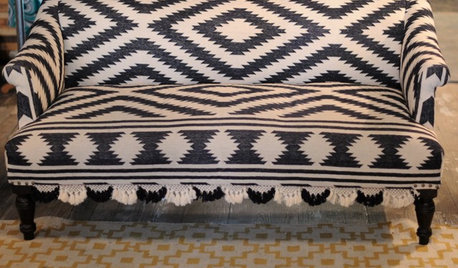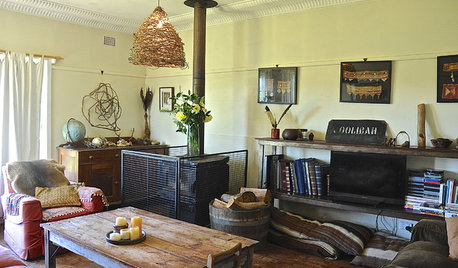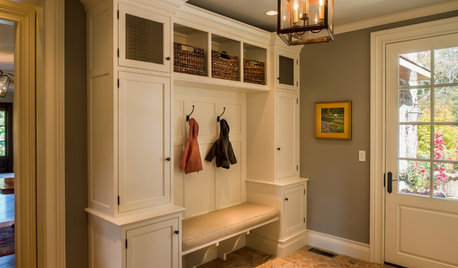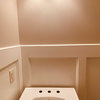Ditra and an electric mat....
saxmaan1
16 years ago
Featured Answer
Sort by:Oldest
Comments (40)
bill_vincent
16 years agomahatmacat1
16 years agoRelated Discussions
Ditra with Electric Mat on a concrete slab
Comments (0)Folks, Thank you in advance for any help! I am remodeling my basement bath and would like to use Ditra for the floor. I also have a custom electric mat for my space. What is the sequence of layers? Will the Ditra be installed on the concrete foundation with unmodified thinset and then the electric mat or vice versa? Thanks, Jaya...See MoreBlanke UNI-Mat Pro vs Schluter Ditra
Comments (2)Ditra is better because they invented the supportive uncoupling membrane system in the first place, are more widely distributed, and have a more responsive service department....See Moreditra over suntouch radiant heat floor mat
Comments (6)On Wed, Aug 5, 2009 at 3:43 PM, barredrock <....> wrote: [This message originated at GardenWeb] thanks for your input so far. this is what im doing now on the bathroom floor, see what you think so this is what im thinking. in this order, tell me what i am or aint doing right thanks 1. I believe it is 5/8 tongue and groove osb 2. 1/4 inch hardibacker 3. suntouch heated floor mat embedded in modified thinset and let dry how long before applying tile? 4. Do i need a leveler???? 5. ditra with unmodified thinset on both sides 6. tile ------------------------------------------ Answers Step Zero is missing. Step 1 is not enough. Step 2 is good. With expensive screws. Step 3 is good. Depends on the instructions on the bag. E.g. eighteen hours or so. Step 4 not unless you think you need it. Are these humungous tiles or puny tiles? Do you have a 6' level and what does it look like when laid on the floor in various directions? With thinset you can compensate easily up to a point.... but that all depends. Step 5 may be unnecessary, but it depends on Step 1 and Step Zero (what joists you have) Ditra is good for slabs that may crack a bit and widen horizontally. It might help also on Hardibacker or any other CBU on wood. But this has been debated a lot and never "proven" a.f.a.i.k. If your floor is springy, Ditra won't compensate enough to make it worthwhile. Step 6 what size is your tile? Have you tiled before? Do you know what slaking is? Etcetera... -- David...See MoreHelp please. Ditra Mat or Blanke over plywood for tile?
Comments (1)All depends on how your floor system is constructed...joist size, span and how spaced. Also, Ditra can only be used for stone installations over wood when the floor system is double layer construction. You're going to have more than 3/8" when you're done with any tile installation. You have the thickness of the tile, the 1/8" thickness of the Ditra and any thickness the thin set motar layers will add to the formula. You will probably come in at about 5/8". Get what you want...if it means ordering a different wood product from a different source, then maybe that is what you may want to do. Lots of engineered flooring out there. I don't do enough of the stuff to give you brand suggestions, however Mirage, Mercier, Andersen are just a few to look for. Look at what the big box stores have and then find independent flooring retailers and see what they have. Lots of stuff is made overseas (China), so be aware and informed as to what you may be buying. Some folks are happy with engineered and some are not. Although color matching is pretty good these days, Lowes should not have shipped you product from different lots. Have you been to the Schluter site? Here is a link that might be useful: Schluter Ditra...See Moresaxmaan1
16 years agobill_vincent
16 years agosaxmaan1
16 years agomahatmacat1
16 years agosaxmaan1
16 years agobill_g_web
16 years agomahatmacat1
16 years agopete_p_ny
16 years agopete_p_ny
16 years agotom_p_pa
16 years agoMongoCT
16 years agosaxmaan1
16 years agotom_p_pa
16 years agobus_driver
16 years agoMongoCT
16 years agosaxmaan1
16 years agoMongoCT
16 years agobill_g_web
16 years agobus_driver
16 years agosaxmaan1
16 years agosaxmaan1
16 years agopete_p_ny
16 years agoMongoCT
16 years agobus_driver
16 years agopete_p_ny
16 years agoMongoCT
16 years agobill_vincent
16 years agobus_driver
16 years agoMongoCT
16 years agobill_vincent
16 years agopete_p_ny
16 years agobill_vincent
16 years agoMongoCT
16 years agobill_vincent
16 years agobus_driver
16 years agosaxmaan1
16 years agoperryduffy_gci_net
13 years ago
Related Stories

GARDENING GUIDESPut Out the Welcome Mat for Leafcutter Bees in Your Garden
Provide a diversity of flowering plants from spring through fall for these charismatic native bees, and you won’t be disappointed
Full Story
BATHROOM DESIGNWarm Up Your Bathroom With Heated Floors
If your bathroom floor is leaving you cold, try warming up to an electric heating system
Full Story
SMALL HOMESHouzz Tour: Teatime for a Tiny Portable Home in Oregon
A tearoom, soaking tub and bed of tatami mats recall Japan in this 134-square-foot house on wheels
Full Story
Street Smart: New Ways With the Zigzag
The classic chevron is still electric. Here's how to bring its energizing updates home
Full Story0

FLOORSFloors Warm Up to Radiant Heat
Toasty toes and money saved are just two benefits of radiant heat under your concrete, wood or tile floors
Full Story
HOUZZ TOURSMy Houzz: Cozy Country Meets Bohemian Artistic in Australia
Healthy helpings of salvage and rustic art give a pastureland home free-spirited style
Full Story
ENTRYWAYSGet a Mudroom Floor That’s Strong and Beautiful Too
Learn the flooring materials that can handle splashes and splatters with ease and still keep their good looks
Full Story
FLOORSWhat to Ask When Considering Heated Floors
These questions can help you decide if radiant floor heating is right for you — and what your options are
Full Story
BATHROOM DESIGNHow to Settle on a Shower Bench
We help a Houzz user ask all the right questions for designing a stylish, practical and safe shower bench
Full Story
GREAT HOME PROJECTSHow to Add a Radiant Heat System
Enjoy comfy, consistent temperatures and maybe even energy savings with hydronic heating and cooling
Full Story




tom_p_pa